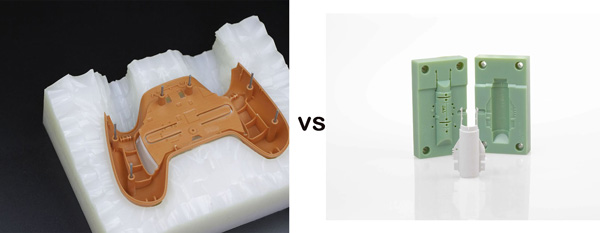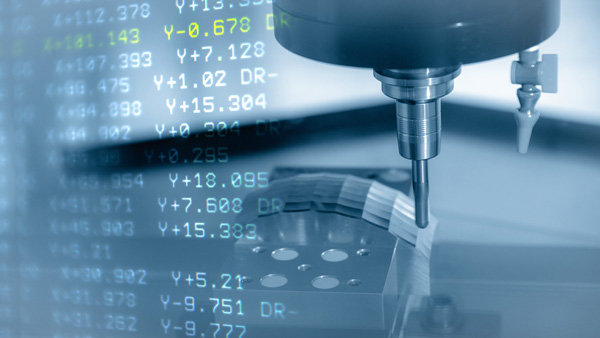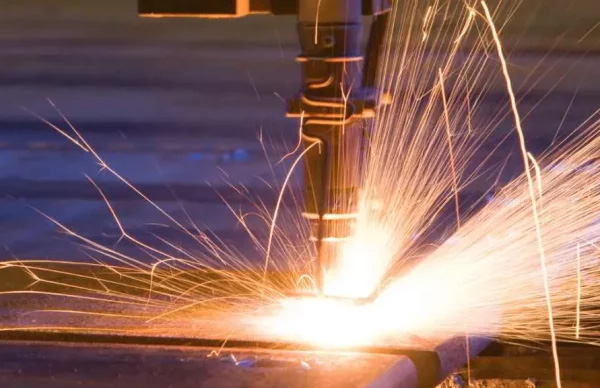Stuck deciding whether to use insert mold vs overmold for your next project? You’re not the only one. Selecting the right method for strength, comfort, and cost efficiency is a common challenge among designers.
In this guide, we’ll walk you through the differences, real-world applications, and expert advice so you can make decisions with confidence. No more guessing!
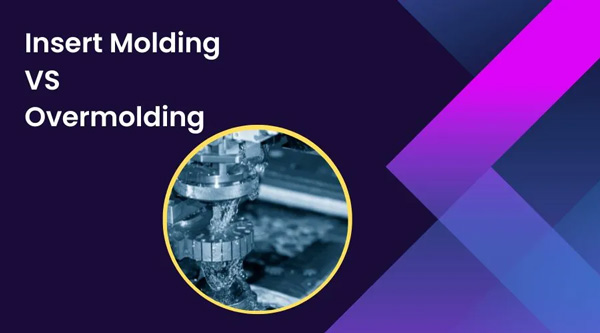
1) What Is Insert Molding / Overmolding?
Insert molding and overmolding are common terms in manufacturing processes, but both processes differ slightly regarding some factors. So, to make a wise decision between these two, it’s important to know every detail about each. So, let’s get started!
Insert Molding
Insert molding is a type of molding technique in which the whole story revolves around a metal piece (typically metal or another dense material). Actually, the part known as the insert is positioned into the mold before plastic is injected. Then, molten plastic flows over the insert and solidifies around it.
After solidification, the part is removed from the mold. Now it is a piece that is made of plastic with having metal part locked inside. Insert molding is more popular in simple items such as cable connectors, threaded inserts, and medical instruments.
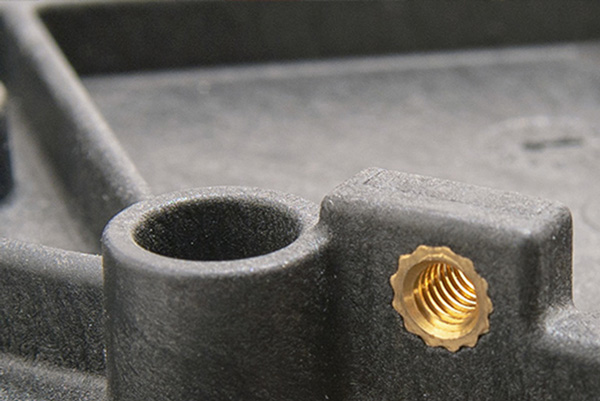
This technique is beneficial when extra strength is required ( as we are adding an internal support of metal). Apart from this, due to the inner metal part present, there are fewer chances that you waste your time and money.
Overmolding
Another method is overmolding; this involves applying one layer of material directly on top of an already existing part. First, a base part is made from harder plastic than soft rubber or softer plastics from the second layer enveloping the first one.
This can be observed on toothbrushes, power tools, and other kitchen utensils that have soft grips. One of the most significant benefits of overmolding is improved feel and comfort, which makes items easier to hold. Apart from this, water resistance along with shock protection can also be enhanced further through overmolding.
Both these techniques have their own unique approaches to combining materials, but the starting point of each process makes us discuss insert molding vs overmolding. To be simple, insert molding is initiated by putting a non-plastic part within the mold. Overmolding builds onto plastic components that have already been molded.
Well, what is the differentiation between insert molding and overmolding? The distinction lies in the materials utilised as well as the sequence of processes. Insertion uses external components, whilst overmolding employs additive creation on already existing molded elements, still there are further developments in overmolding process.
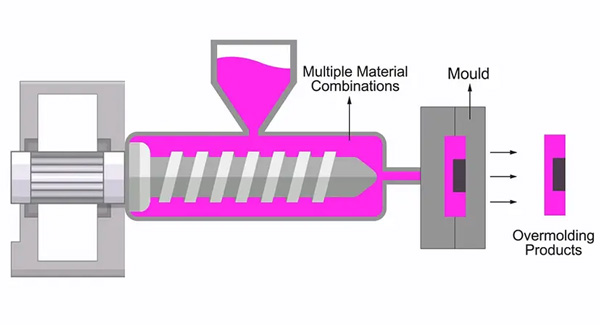
2) Why Use Insert Molding or Overmolding?
These two techniques also help you create stronger products. Let us check how they can be beneficial.
- a) Less Assembly Work: With increased automation, there is less need for labour work. So, it saves time and money.
- b) Better Grip and Comfort: Have you ever done strenuous work with tools that hurt your palms? Using comforting synthetic materials makes devices easier and smoother to hold than plastic.
- c) Added Strength: Inserting metal components into plastic performs a dual function where not only does it enhance the durability, but also reinforces the area that sustains a lot of force.
- d) Clean, Seamless Look: These methods ensure that all gaps, loose parts, or bulky joints are eliminated because everything works in a perfect manner, allowing you to achieve, without much strain or effort. High-quality finishing touches on the product give products magnetic effects depending on the light angle, offering seamless polish.
- e) Fewer Part Failures: With one-piece molded materials, weak points due to traditional assembly are eliminated. This leads to reduced failures of components and enhanced longevity of products.
- f) Greater Design Freedom: With insert molding, you can achieve functional and artistic creativity in designs much greater than with overmolding.
- g) Improved Electrical Safety: Insert molding is best for electronic devices because it allows you to encase wires or connectors in plastic safely. So, it protects users from electric shocks while increasing the durability of the device.
3) Comparing overmold vs insert mold
A question can arise in your mind: What is the difference between insert molding and overmolding? Well, each method features distinct objectives, workflows, and advantages. Let’s have a look;
| Feature | Insert Molding | Overmolding |
| Base Material | Metal or solid insert | Molded plastic part |
| Second Material | Thermoplastic | Soft plastic or rubber |
| Goal | Strength, function, durability | Grip, comfort, surface protection |
| Common Use | Connectors, fasteners, electronics | Handles, grips, tools, wearables |
| Tooling Complexity | Higher | Moderate |
| Design Flexibility | Best for embedding functional elements | Best for ergonomic and soft-touch designs |
| Cost Factor | Higher setup cost, durable output | Lower part count, reduced labour |
i) Process Type
Insert Molding: A form of molding whereby a metal or solid piece is placed into the mold cavity first. Then, plastic is injected to encapsulate it and bond completely as one part for added strength.
Overmolding: The first stage consists of manufacturing a rigid component from plastic. This is then followed by an additional stage whereby another material gets molded onto the previous one to produce a composite structure.

ii) Materials
Insert Molding: Typically uses thermoplastic materials with metal inserts for proper reinforcement and a strong body since the insert remains captured in the mold.
Overmolding: A firm plastic base with a soft rubber-like upper layer provides better surface feel and flexing capability, improving usability and enhancing performance.
iii) Function
Insert Molding: Particularly useful when manufacturing parts that are meant to be strong, threaded, or require electrical connectivity, as this process improves the support structure significantly.
Overmolding: Best to boost grip, comfort, protection, and also improves water-tight seals.
iv) Assembly Needs
Insert Molding: Lessens components that require assembly by removing segmented parts during molding.
Overmolding: Elimination of secondary assembly through bonding materials simplification. It eliminates of use of adhesives, hence simplifies production sessions.
v) Setup
Insert molding: It needs the right tools to hold onto the insert in the correct position during molding processes. This makes the setup a bit complex.
Overmolding: Requires two-step molds, but is simpler if you are dealing with plastic projects. Well, processes are smoother when bonding between materials occurs more readily.
vi) Design Flexibility
Insert Molding: Works best for the integration of internal metal parts, as no additional shape alteration is needed.
Overmolding: It offers more flexibility regarding shape, colour, and design of the product.
vii) Cost Considerations
Now let’s discuss the overmolding vs insert molding cost:
Insert Molding: Often has increased costs from initial tooling and handling, but the results produced are strong and durable.
Overmolding: Cuts overall expenses by lessening part count and post-processing work done.
| Feature | Insert Molding | Overmolding |
| Base Material | Metal or solid insert | Molded plastic part |
| Second Material | Thermoplastic | Soft plastic or rubber |
| Goal | Strength, function, durability | Grip, comfort, surface protection |
| Common Use | Connectors, fasteners, electronics | Handles, grips, tools, wearables |
| Tooling Complexity | Higher | Moderate |
| Design Flexibility | Best for embedding functional elements | Best for ergonomic and soft-touch designs |
| Cost Factor | Higher setup cost, durable output | Lower part count, reduced labour |
4) When to Use Overmolding vs Insert Molding
Your product’s requirements will determine when to use overmolding or insert molding. Each one has specific benefits, as we shall see based on six critical aspects.
? Choose Insert Molding for Added Strength
When strength is a priority, insert molding is the preferred option. You know it allows the molding of plastic around the metal parts, for example, pins or threads, or bushings. This enhances the resultant part’s strength.
? Use Overmolding for Grip and Comfort
Overmolding products makes them easier to grip for users. It covers a rigid plastic base with a softer layer, which works well for tools, handles, and other items.
? Insert Molding Reduces Assembly Time
With insert molding, some parts are fused together during the molding operation as components are added simultaneously throughout the process. There’s no longer any requirement for glue or screws, nor does installation take place afterward. So, if you are in a hurry, these advantages save time and cut costs while improving accuracy.
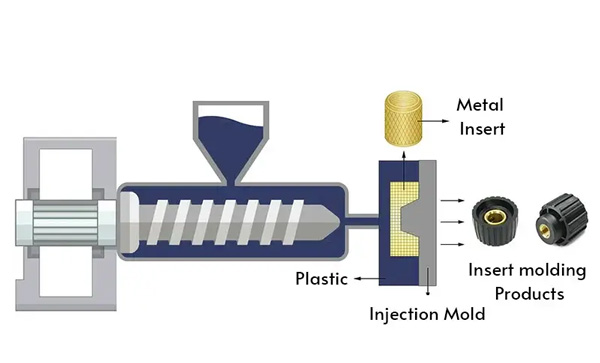
? Overmolding Improves Appearance and Protection
Overmolding enhances the aesthetics as well as the safety features of items or devices by enabling the addition of colour, texture, or soft finishes to already existing designs. In addition, it provides better insulation from external factors such as shock and moisture damage.
? Match the Process with Product Purpose
Examine what your component actually needs. Need some built-in strength or functional metal parts? Go for insert molding. For added comfort, grip, or general user appeal, overmolding works better.
? Consider Material Compatibility
In considering conflicts between insert molding and overmolding, material compatibility foremost comes to mind. In the case of overmolding, strong adhesion is essential to ensure a good bond between the base material and top material, usually two types of plastics. With insert molding, there is greater ease in combining metals and plastics.
5) Produce Your Parts with Overmolding or Insert Molding
If you are looking for high-quality part production using overmolding or insert molding, Koonze Model is the go-to choice. We provide unmatched advantages such as precision speed, and support all together in one seamless package.
-
- One-Stop Injection Molding Partner: Koonze offers both services with no need to go elsewhere for additional vendors. It simplifies communication, keeping everything done under the same quality standards without juggling multiple vendors.
- No Minimum Orders: Like many other manufacturers, Koonze allows you to place orders of even a single part, which makes testing prototypes easier. It makes the Koonze Model flexible, not requiring limits on order quantity for both options of insert molding or overmolding.
- Fast Lead Times: Need parts urgently? Koonze can deliver samples in just one day. For full orders, the turnaround time is just a few days. This efficiency applies to both overmolding and insert molding projects.
- High-end Quality Control: We hold ISO‑9001, IATF‑16949, and ISO‑13485 certifications, which show that quality is maintained at every step, including mold design and final inspection. These certifications also ensure that the processes of overmolding and insert molding are done with precision.
- Expert Engineering Support: Koonze’s team analyses your files to give DFM feedback to help select the right materials, trim costs, and improve designs before production.
- Wide Range of Materials and Processes: With a wide variety of thermoplastics including ABS, PP, PC+GF30, alongside other metal inserts, be it soft touch grips or threaded metal strength, you can order parts according to your specific requirements.
- Scalable Production: Start small, then scale up! Rapid prototyping coupled with full-scale production makes the process easier.
How to Collaborate with Koonze Model
- You may upload your CAD or technical drawings on the website www.koonze-rapid.com/
- Receive a no-cost quote and DFM review in less than one day.
- Approve the prototype (T1 sample) and proceed to large-scale production.
- Get your parts delivered, often within two weeks for T1 and 1–15 days for full orders.
6) Applications of Overmolding or Insert Molding
Both insert molding processes have applications in various fields. They assist in making products that are durable, as well as comfortable and effective. Let us examine how these two techniques are applied.
- Consumer Products
Overmolding: In grips and comfort in daily purchase products is critical. Overmolding is applied to razors, toothbrushes, kitchen utensils, and pens to increase their ease of use. The soft rubber coating improves the user’s grip on the product, making it more enjoyable to use.
Insert molding: Here also insert molding also has its application. It is used in small electronic devices or accessories storage boxes, which are made from plastic. It improves strength while maintaining the simplicity of the item.
- Medical Devices
Insert molding: In health care, safety and efficiency are vital considerations. For needles or surgical tools with plastic handles, insert molding is used to securely fasten metal parts. Well, this minimises the effort needed for manual assembly to provide a solid structure.
Overmolding: It assists in designing soft-touch grips for medical devices to make them be comfortable. Also used for soft seals, covers, and flexible portions for surgical tools where hygiene or comfort is key functionality.
- Automotive Industry
Insert molding: Components in vehicles require the efficiency, precision, and quality of engineering to cope with stress and long-term damage. Cable connectors, dashboards, switches, and similar parts, and plastic housing components undergo insert molding.
Overmolding: Parts used by drivers also include buttons and steering wheels. Their gear touch improvements result from overmolding while reducing vibrations plus improving aesthetic appeal.
- Electronics and Electricals
Insert molding: Plugs, connectors, or USB ports can have contacts embedded into them using the insert molding technique, making it best suited for such applications. This method ensures that everything remains protected and robust within a small-sized package.
Overmolding: It is used to seal wires, chargers, or circuit boards. Thus, it cuts off moisture and, with other damaging factors, ensures complete sealing and protection from all ends.
7) End
Deciding between overmolding and insert molding comes down to your product’s requirements: its strength, comfort features, or aesthetics. Each technique has its advantages tailored to specific uses.
To be honest, Koonze Model is a reliable partner if you are prepared to bring your design to life. We provide professional insight and quality production with quick turnaround times for both overmolding and insert molding projects. It’s effortless to begin because there are no minimum order amounts, and cost-free estimates are provided.
Contact Koonze Model right now!


